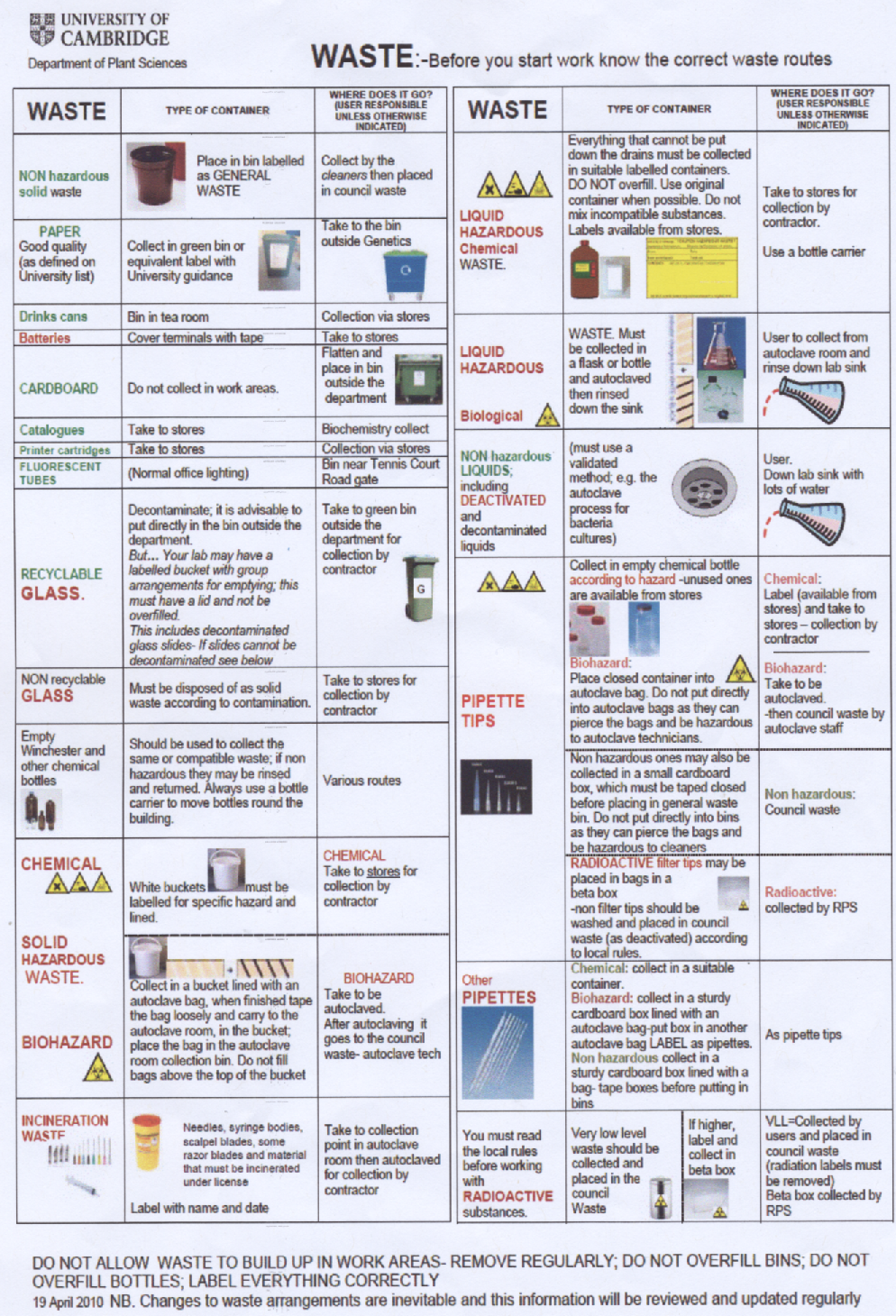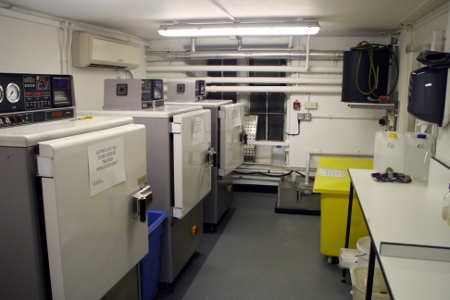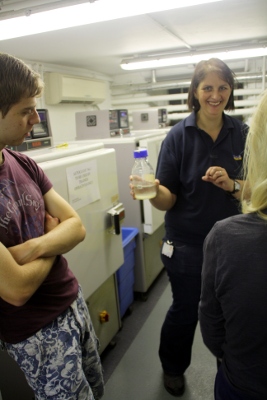Team:Cambridge/Safety
From 2011.igem.org
(→Security Risks) |
|||
| Line 42: | Line 42: | ||
All items which have come into contact with bacteria must be [https://2011.igem.org/Team:Cambridge/Safety#Autoclave autoclaved] before disposal, and neither lab-coats nor gloves should leave the laboratory. | All items which have come into contact with bacteria must be [https://2011.igem.org/Team:Cambridge/Safety#Autoclave autoclaved] before disposal, and neither lab-coats nor gloves should leave the laboratory. | ||
| - | + | Nevertheless, accidents do happen - hence, we have taken care to pick a project that poses minimal biosafety risks even in the event of accidental release from a laboratory. Should an organism containing the reflectin expressing gene escape from the lab, we do not anticipate any significant hazards for the public or the environment since we do not intend to increase the host range of the host bacteria, nor alter its pathogenicity. Since we will be working with multiply disabled strains of E. coli (which cannot survive in the gut, unlike pathogenic strains), this should render our bacteria effectively harmless. Since the protein that we are looking to produce originate from an edible squid, there should also be no toxicity or pathogenic issues associated with working with reflectin. The biobricks we produced thus also have no particular biosafety risks associated with them. As a consequence, we do not think that our genetically modified bacteria could be maliciously misused in any way that could pose a security risk either. | |
| - | + | ||
| - | + | ||
| - | + | ||
| - | + | ||
| - | + | ||
| - | + | ||
| - | + | ||
| - | + | ||
| - | + | ||
| - | + | ||
| - | + | ||
| - | + | ||
| - | + | ||
| + | The low-risk nature of our project is no accident; these considerations featured heavily in our [https://2011.igem.org/Team:Cambridge/Brainstorm brainstorming] sessions, and we discarded many potential project ideas because of their potential biosafety implications. This is the kind of practice we would like to encourage more iGEM teams to take seriously when choosing a project, since after browsing through past work by iGEM teams, it seems like many of the ideas would not have passed our stringent biosafety checks! Check out some of our suggested guidelines [https://2011.igem.org/Team:Cambridge/Brainstorm#Responsibilities_when_working_with_GMOs here]. | ||
<br style="clear: both" /> | <br style="clear: both" /> | ||
{{Template:Team:Cambridge/CAM_2011_TEMPLATE_FOOT}} | {{Template:Team:Cambridge/CAM_2011_TEMPLATE_FOOT}} | ||
Revision as of 15:01, 25 August 2011
Safety is of utmost importance during projects involving synthetic biology. Not only must the welfare of scientist and non-scientific staff within the department be considered, but also that of the wider community. It is therefore important that safety procedures are in place to minimise the risk of harm to both employees and the wider community.
This has been implemented in our lab in many ways. We took care that everyone in the team was fully aware of all the safety protocols by attending a presentation given by our lab safety officer, Barbara Landamore, and reading the Department's Code of Practice for working with genetically modified (GM) organisms before being granted GM worker status.
Contents |
Biosafety regulations
The biological safety officer for our department is Dr Ed Tanner, so he has been the first port of call whenever anyone has had any doubts about biosafety measures. An interdepartmental team, the Cambridge Biosafety Group, has reviewed our project brief and has passed our nominations for all members of the team to be able to work with [http://en.wikipedia.org/wiki/Biosafety_level Biosafety level one] organisms in the Plant Sciences department, which is itself an approved containment level one facility. We have thus been cleared to work with bacteria that have been classified as being "unlikely to cause human disease". However, before carrying out any work with GM bacteria, the relevant risk assessment forms must be submitted to the Head of Group within the Department for approval.
Working in the UK, there are also [http://www.hse.gov.uk/biosafety/gmo/law.htm national biosafety regulations] that we were made aware of before beginning our project. We have complied with all of these guidelines, and hence have worked well within the law.
Safety inside the lab
The proper waste disposal routes were followed stringently in order to prevent the reagents and biological material that we worked with from causing any harm to the environment or the general public. Within the lab, MSDS sheets were consulted whenever we planned to use new chemicals/reagents, to ensure that all possible safety hazards had been taken into consideration before any accidents could happen. The safety precautions that we took are all outlined in the description of our experimental methods in the protocols section. In this way, we managed to avoid any serious incidents from occurring over the summer.
Waste Disposal
Disposing of equipment used for experimental purposes is a significant challenge, and detailed procedures are in place within the department in order to ensure the safe disposal of all materials, or their recycling where possible. The chart below outlines our departmental waste disposal policy - it is currently up on our wall in the lab.
Autoclave
All reasonable measures must be taken to prevent the release of biological material from the department, and so all biological matter must be autoclaved before disposal. Specific guidelines for this procedure are outlined below.
Glasses for autoclaving should be:
- Only partially filled: the solution will boil during autoclaving and hence expand
- Lidded (loosely) - gas must be able to escape (to prevent explosion)
- Labelled 'iGEM' so any problems can be reported back to us
- Left on the table to the right (see picture)
- Collected from the autoclaving room
Other equipment, e.g. petri dishes, should be bagged, labelled and placed in the yellow box to the right (see picture). If the items are sharp (and hence could penetrate the autoclave bags, presenting a hazard to autoclave technicians) then they should be placed in a secure closed container before being bagged.
Items which are unsuitably prepared for autoclaving (e.g. loose pipette tips in bags) wil be returned, and will not be autoclaved until they are prepared appropriately for the procedure.
Containment
Genetically modified material must not be allowed to leave the laboratory. While the likelihood of the strains of bacteria with which we will be working surviving in the wild is low, the environmental impact of such an event could be severe, and thus every reasonable precaution must be taken to prevent such an occurrence.
Since we will only be working with biosafety level one organisms, our work can be carried out on open bench tops, but gloves and lab coats must be worn during experimentation in order to protect the worker and reduce the risk of contamination. Within the lab, 'wet' experimental work was restricted to the 'Wet Area' whereas write-ups and computing work took place solely in the 'Dry Area'. Coats, bags, laptops and other belongings were also restricted to the Dry Area. These areas were clearly segregated to ensure nothing that left the lab could have come into contact with biological material at any point, further confining the biological material. All items which have come into contact with bacteria must be autoclaved before disposal, and neither lab-coats nor gloves should leave the laboratory.
Nevertheless, accidents do happen - hence, we have taken care to pick a project that poses minimal biosafety risks even in the event of accidental release from a laboratory. Should an organism containing the reflectin expressing gene escape from the lab, we do not anticipate any significant hazards for the public or the environment since we do not intend to increase the host range of the host bacteria, nor alter its pathogenicity. Since we will be working with multiply disabled strains of E. coli (which cannot survive in the gut, unlike pathogenic strains), this should render our bacteria effectively harmless. Since the protein that we are looking to produce originate from an edible squid, there should also be no toxicity or pathogenic issues associated with working with reflectin. The biobricks we produced thus also have no particular biosafety risks associated with them. As a consequence, we do not think that our genetically modified bacteria could be maliciously misused in any way that could pose a security risk either.
The low-risk nature of our project is no accident; these considerations featured heavily in our brainstorming sessions, and we discarded many potential project ideas because of their potential biosafety implications. This is the kind of practice we would like to encourage more iGEM teams to take seriously when choosing a project, since after browsing through past work by iGEM teams, it seems like many of the ideas would not have passed our stringent biosafety checks! Check out some of our suggested guidelines here.
 "
"



